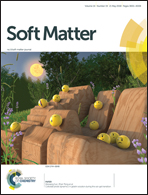Study on influencing factors of Pickering emulsions stabilized by hydroxyapatite nanoparticles with nonionic surfactants
Abstract
Emulsions were prepared using hydroxyapatite nanoparticles and nonionic surfactant sorbitan monooleate (Span 80) as emulsifier. Effects of Span 80 concentration, emulsification time, emulsification rate, poly(L-lactic acid) (PLLA) concentration and the surface chemical properties of hydroxyapatite nanoparticles on emulsion properties were systematically studied. The results showed that emulsion would undergo a phase inversion from oil-in-water (O/W) type to water-in-oil (W/O) type with an increase in Span 80 concentration. All of the above factors are closely related to emulsion type and stability. SEM results indicated that cured materials with different structures were obtained using these emulsions as templates via in situ evaporation; especially, open-cell porous structures were obtained by a mixture of hydroxyapatite and a moderate concentration of Span 80. The mechanism of this emulsion system is proposed in relation to the emulsion properties and cured material structure, which should be attributed to the formation of hydrogen bonds between hydroxyapatite and Span 80 by hydroxyl groups as well as their location changes in the emulsion.



 Please wait while we load your content...
Please wait while we load your content...